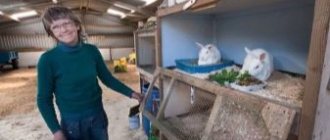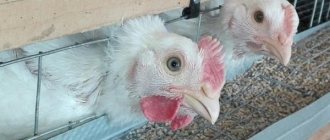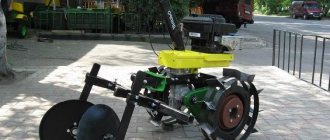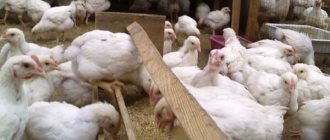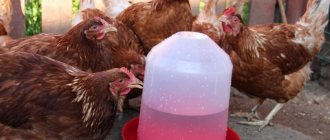Cell requirements
The chicken is an unpretentious creature, but loves comfort. The better the bird feels, the more productive its maintenance will be for the owner.
Chicken cages are made according to specific drawings
When building pens for laying hens, important points are taken into account:
- The device must not have blank walls.
- Cages are made at the rate of 600 cm² of area for one laying hen. If the birds are too crowded, their egg production will sharply decrease. To keep egg-meat chicken breeds, the area should be increased to approximately 800 cm² - such individuals are large in size.
- Each section is equipped with a drinking bowl/feeder.
- The structure has a durable floor - rotting litter may collapse over time.
- The structure must always be dry and warm.
- The grid must be reliable, with medium-sized cells. This is the main requirement during construction. Predators such as weasels and ferrets will not be able to get into such a home. The front wall has the largest mesh - chickens stick their heads through it to consume food.
The cage is installed in chicken coops or barns. In the summer, they and the chickens are taken out into the air. To avoid leaks in rainy weather, the roof of the poultry house must be solid and impermeable to moisture.
Slate sheets or similar material are used as covering.
Selection of chicken breeds
The best breeds of chickens for cage keeping are considered laying crosses or a combined version (meat and egg production). Unpretentiousness, rapid growth and weight gain, resistance to diseases are the main arguments in their favor.
Leghorn chickens have predominantly white dense plumage, a small head with a yellow beak, and a bright red comb. The bird's egg production is 200-250 eggs with white shells per year, weighing up to 60 g.
Egg production rates drop after the first year, so they are chosen if birds are being renewed for the next year. Chickens are quite resilient and survive well. You should not expect large carcasses from this breed, although it can be fattened. Kuchinsky Jubilee meat-egg crosses are distinguished by large, spectacular roosters, whose red-brown plumage attracts the eye.
The best breeds for keeping in cages are: Kuchinsky, Leghorn, Loman Brown and Hisex Brown.
They have a dark tail and collar. The hens are golden brown, round, and have bright red straight combs. Up to 250 selected, uniform eggs are laid. The shell is light brown. They gain weight quickly and require strict adherence to nutritional standards so as not to become obese. Over time, egg laying decreases, but by that time the resulting carcass is quite massive.
Hisex Brown is a meat-egg hybrid with a very high egg production (350-360 eggs per year). The golden-brown plumage is dense and the bright red crest often hangs to one side. Egg production rates remain at approximately the same level for several seasons. For normal weight gain and egg laying, larger cages, proper balanced food, and diligent care are required.
Calm, non-aggressive Loman Browns are characterized by high egg productivity (310-320 eggs per year), excellent taste of meat, and a large leaf-shaped comb. Replacement of laying hens with young animals is carried out after 3 years.
Cage for laying hens: pros and cons
In a chicken house, animals are kept in the smallest possible area.
When constructing cages, it is imperative to provide an artificial lighting system
The advantages of these structures include:
- saving space, heat and lighting in winter;
- low costs for bedding cover;
- a simplified option for cleaning the structure compared to poultry pens;
- saving on feed - chickens do not rake food with their paws, and due to a sedentary lifestyle, they burn a minimum of calories and eat less;
- reduction in water costs - drinking bowls remain clean, pieces of litter and various debris do not fall into them;
- the percentage of birds eaten by predators is close to zero;
- low risk of contracting diseases from contact with wild animals;
- simplified process of collecting eggs - you don’t need to look for them on the floor or in secluded places where free-roaming laying hens are used to laying eggs.
Cage keeping of birds has several disadvantages:
- due to the small space in chickens, the percentage of egg production may decrease - they are active creatures, they like to walk a lot;
- pets are limited in the consumption of natural food (greens, insects, plant seeds), which they get from free grazing, as a result of which they should be additionally fed with vitamin complexes and mineral mixtures;
- lack of sun, which saturates birds with vitamin D;
- instant spread of infection - in a confined space, the disease affects almost the entire livestock if proper measures are not taken in time.
Be sure to read:
How to quickly catch a wild ferret or marten in a chicken coop and how to get rid of the predator
Possible problems
Cellular fatigue
Caging hens in cages tires their bones and muscles.
The bird loses the ability to stand on its feet due to brittle bones. Because of this, she constantly lies down and stops eating. Egg shells become thinner.
When such a disease appears in chickens, you need to pay attention to their nutrition. Add calcium and phosphate to the menu.
Panic
When a hen is about to lay eggs, she needs privacy. It is impossible to achieve such conditions in a cage. Because of this, the hen begins to panic. She begins to rush around the cage randomly, breaking off feathers and injuring her limbs. As a rule, this goes away after 2-3 layings.
The solution is to isolate the restless bird. And creating comfort for her: a cozy nest, dim light, closed walls, warmth. It is important to diversify her menu with useful substances. For example, fruits, vegetables, herbs, worms, chalk.
Cannibalism
Adult laying hens can show aggression towards cage mates. Peck, pounce.
It is recommended to separate such chickens from the general flock. There are even more tips in the article “Chickens peck each other until they bleed: why and what to do.” If all else fails, the aggressor is slaughtered for meat.
Wing fracture
The fracture is difficult to detect if chickens are kept in cages.
If your chicken can't straighten its wing, or if it's drooping, it may be injured or broken. It’s the same with the paws if the bird falls and cannot get up.
It is better to show the laying hen to a veterinarian. If this is not possible, you need to fix the affected wing or paw with a splint and bandage in its natural position.
Rickets
This disease is common among laying hens and young chickens. Signs of the disease: loose stools, loss of coordination and appetite, softening of the key and claws. It is not easy to recognize in the early stages. Patients must be isolated and treated:
- tricalcium phosphate: 1.5 milliliters per 100 grams of feed;
- fish oil: 0.5 milliliters per 100 grams of food;
- vitamin D2 concentrate: 2-3 drops per kilogram of feed.
No matter how long chickens live in cages, all this time they need care. It is recommended to systematically inspect, monitor the nutrition and living conditions of laying hens.
If you liked the article or have experience keeping chickens in cage conditions, please leave comments and share your knowledge. Perhaps your opinion will be useful to our readers.
Please spread the information on social networks by reposting. Special thanks to everyone for rating this article 5 stars.
Construction of laying hen cages
Every farmer can make a pen for laying hens with his own hands.
For this, any available materials are suitable, from which well-ventilated, hygienic housing is built.
The best option is a durable metal mesh, often galvanized.
The material is not subject to corrosion, lasts a long time, and does not deform under the weight of the flock. The net is attached to a wooden or metal frame, and a bright house for the chickens is ready.
Homemade cages that are too large are inconvenient to use, it will be difficult to get to the drinking bowl and feeder, and the trays with droppings will be very heavy
Egg trays are installed at the front edge of the flooring. The floor itself is made of fine mesh, making a slope of 7-10° in the direction of the front wall.
The laid eggs roll into the egg receptacle groove and lie until the time of removal. The chicken cannot touch it, damage it or peck at it.
At a distance of 100-150 mm below the floor, gutters are constructed to collect feces. Craftsmen use plastic trays from the store for this or make them themselves from tin sheets.
For rooms with large parameters, several gutters are installed - this greatly facilitates the cleaning process.
The feeder is fixed to the front wall along its entire width. It is located above the egg receptacle. A drinking bowl is installed above the feeder so that the birds can freely reach the food and water.
The cells on the front side are made 5x10 cm in size so that the birds can stick their heads out and reach the feeder. If the mesh is too small, you can remove several rods from the grid.
It is better to make the back and side walls of the bird's home lattice - this will facilitate the ventilation process and provide the pets with fresh air.
The size of the bird, which belongs to the egg breed, is relatively small, and therefore there is no point in making cages that are too high
Some farmers prefer to make the sides from OSB, plywood and similar building materials.
The roof is made of mesh for good air movement, but in the summer, when it rains, it will have to be covered with something to prevent moisture from flowing into the house.
The top of the cage is made of plywood or waterproof tiles, making a small slope for water to roll off.
The poultry house door is made to open or fold down and is installed on the front wall of the structure.
In single-tier buildings, a folding roof is sometimes installed - this greatly facilitates access to the chickens and makes it possible to easily handle or clean the house.
The nuances of making an inclined egg collector
Cages with an egg collector are recognized as one of the most convenient for laying hens, but their whole secret lies only in the inclined position of the floor. When a chicken lays an egg, it does not roll along the floor, but is carefully rolled into a special tray, which is located outside the wall.
An additional advantage of this design is that the mesh floor does not need to be removed and covered with bedding, since the droppings will fall through the mesh cells directly into the tray, which only needs to be cleaned regularly.
To make a cell with a similar mechanism, several nuances should be taken into account:
- the floor must be hard, so it should be made of wire with a thickness of at least 3-5 mm, otherwise it will sag under the weight of the hens;
- the ceiling and side walls do not need to be made blank, so they can be made from a mesh with cells measuring 25x50 mm;
- the front wall should be made of mesh with larger cells - 50x50 or 50x100 mm (to obtain the front wall, you can simply fasten the rods at a distance of 50 mm).
Here is a diagram of a cage with an inclined egg collector:
1 - drinking bowl; 2 - door; 3 - feeder; 4 — tray for collecting eggs; 5 – tray for litter.
Having prepared the appropriate frame, you can make the chicken cage itself:
- Attach a mesh to the frame to obtain the first floor (No. 5 in the diagram). A tray will be placed on it to collect litter.
- Make a second inclined floor from fine mesh and attach it to the frame at an angle of 8-9 degrees (No. 4 in the diagram). When installing an inclined floor, you need to take into account that its mesh should protrude 15 cm beyond the front wall. Its edges must be folded to create a container for collecting eggs.
- There must be a gap of at least 12 cm between the first and second floors, so that in the future it will be possible to insert a pallet.
- Install the side walls and ceiling, and then use hinges to attach the front wall made of rods or coarse mesh to use it as a door (No. 2 in the diagram).
- The design is almost ready, you just need to attach the drinking bowl to the front wall (No. 1 in the diagram), and below - the feeder (No. 3 in the diagram).
Cage for laying hens: drawings and sketches
A sketch of future cellular equipment is easy to imagine. Its base is made of a medium-sized block, the back wall and sides are made of a medium-sized mesh.
The floor has a double bottom - chickens walk on a mesh floor, and under it there is a metal tray in which droppings and other waste accumulate.
Be sure to read:
How to make a perch for laying hens with your own hands correctly: drawings, photos, videos, dimensions
The mesh covering slopes towards the front wall and ends with an egg receptacle.
Cage for laying hens: drawings
The front wall is made of a lattice with a fairly large mesh or metal rods.
On the front wall above the egg receptacle there is a plywood feeder, and just above it there is a grooved sippy cup. To maintain a large flock, the width of the base is adjusted, other indicators are left the same.
How to make a metal cage?
Before building a cell structure, you need to prepare the following materials:
- metal corner for the frame;
- bolts;
- galvanized welded mesh, the cells of which have dimensions of 25x50 and 50x50 mm;
- tin for the tray and door;
- spring for door and hinge.
Using these materials, a cage is assembled according to the following drawing:
Armed with the necessary materials, you need to prepare the details of the future cell. They are presented in the table:
| Name | Amount) | Dimensions |
| Made from galvanized welded mesh, size 25x50 mm | ||
| Back wall | 1 | |
| Side wall | 2 | |
| Ceiling | 1 | |
| Mesh floor | 1 | |
| Made from galvanized welded mesh, size 50x50 mm | ||
| Front wall | 1 | |
| Door cut from the front wall | 1 | |
| From a corner 2x2 cm | ||
| Legs | 4 | Length – 80 cm |
| Ceiling frame | 4 | 2 frames each, 70 and 60 cm long |
| Mesh bottom frame | 4 | Length – 70 cm |
| Frame for manure tray | 3 | 2 frames 65 cm long and 1 frame 70 cm long |
| Made from steel strip 2 cm wide | ||
| For the front wall | 1 | Length – 74 cm |
| Under the mesh bottom | 1 | Length – 70 cm |
| From tin | ||
| Pallet | 1 | |
Having prepared all the details, you can start making the cage:
- Assemble the frame. To do this, take the prepared parts of the ceiling frame and connect them with bolts so that the corner 70 cm long (gray) is above the corner 60 cm long (orange):
- Assemble a frame for a pallet in which bird droppings will be collected:
- Assemble the mesh bottom frame using the same principle as when assembling the ceiling frame:
- Connect the legs to the ceiling and tray so that the distance between the elements of the back wall is approximately 71 cm:
- Place the mesh bottom frame in its place, as shown in the drawing:
- Attach the steel strip parts to the appropriate places:
- Attach the cut mesh into rectangles to the frame using strong wire. In order for the eggs to freely fall into the egg collector, the distance between them should be slightly more than 6 cm.
- Make a tin border around the door, and then use hinges to attach it to the cage so that it opens freely downwards. Install the spring.
If you equip the cage on the outside with a drinker and feeder, it will look like this:
If desired, the cage can be made into 2-3 floors by increasing its height and using the ceiling of the lower structure as a tray for litter.
Cage sizes for laying hens
For 1 sq. m it is optimal to place 2-8 chickens of meat and egg breed or egg breed.
Birds should be able to freely approach the feeder/drinker without crowding or squeezing their neighbors. To do this, pens are built with a depth of about 50-60 cm, the width is chosen based on the size of the flock - 60-120 cm.
You should not build chicken houses that are too wide - a tray filled with droppings will be very heavy, and the flooring inside the structure will become deformed.
As a rule, the height of the poultry house is 45-50 cm.
Drawing of a cage with 3 tiers
Experienced breeders recommend following the data from the table when constructing poultry houses:
| Number of chickens in the poultry house | 2-3 | 4-5 | 6-8 | 9-12 |
| Depth, m | 0,5-0,6 | 0,5-0,6 | 0,6-0,8 | 0,7-1,0 |
| Width, m | 0,6-1,0 | 1,0-1,4 | 1,4-1,8 | 1,8-2,0 |
| Total height, m | 0,65 | 0,65 | 0,7 | 0,7 |
| Height at the rear wall, m | 0,45 | 0,45 | 0,5 | 0,5 |
| Area for 1 chicken, m² | 0,1-0,3 | 0,1-0,21 | 0,1-0,24 | 0,1-0,22 |
For poultry of the egg-meat breed, the territory should be increased by about 30-40%.
Attention ! Too small a room can result in bird fights, stress for the flock and, as a result, a decrease in egg production.
How to choose a design for your site
The cell is selected taking into account a variety of factors. The main one is the scale of the economy. For 10 laying hens, it is much more rational to build 2 nests than to keep the birds in a cage. If there are more chickens, but there is still no possibility of free range, they prefer to keep them in cages.
- Material - metal is much stronger and more durable, but only if you use galvanized iron. It is much easier to make a cage out of wood. However, it is not so durable and, for example, is not suitable for multi-tiered structures.
- Number of individuals - cages for one individual are usually used in breeding breeds where it is important to track the ownership of the eggs. For egg-bearing animals, the most popular are cages for 4–5 individuals. For large farms, the largest structures are used - for 7 individuals, and installed in tiers.
- Design – cages can be stationary or portable. The first ones are installed indoors and do not move. The latter are equipped with a device for carrying and are placed outside in the summer. Even in the absence of free range, being in the open air and the sun makes the birds healthier.
- Installation method - in normal cases, the cells are installed on supports. The distance from the structure to the floor is determined by convenience. Wall installation is only allowed if the wall is a partition, since load-bearing walls cool too much in winter. The hanging option is less common: this method makes cleaning the room easier, but is more difficult to implement.
When arranging a two-level battery, due attention should be paid to lighting
Tiered structures are most often used on large farms, where it is necessary to place the maximum number of laying hens in a minimum area. This model is not collapsible, but is a single frame with cages and trays installed at some distance from each other.
When using a cage battery to keep laying hens, it is especially important to provide sufficient lighting. Do not allow darkened or overly well-lit areas.
Large farms often use light of different spectrums. As practice shows, alternating red, orange, yellow colors, as well as gradually turning the light on and off, simulating sunset and dawn, has a positive effect on the egg production of laying hens.
Materials for making a cage
Too small a room can result in bird fights.
When building a residential poultry house, laying hens cannot do without:
- pairs of planed wooden blocks 3 m long;
- 5 planed wooden planks 4x5 cm or 4x4 cm, 3 m long;
- galvanized metal grating for the front wall with a mesh of 5x10 cm and a width of 1 m - one roll card (1 lm) or with parameters 0.5x2 m;
- galvanized metal gratings for the ceiling, side walls and floor with a mesh size of 1.5x1.5 or 2.5x2.5 cm and a width of 1 m (roll card 3 lm or with parameters 0.5x2 m);
- self-tapping screws for wood or self-tapping “bugs” for fixing the mesh;
- metal corners for frame screeds or canopies;
- 1.5 mm tin sheet - containers for excrement, or PVC trays;
- PVC pipes or iron sheets - for future drinkers and feeders.
Content
This method of maintenance has a lot of undoubted advantages. It is easier to care for the bird, since the cleaning process itself is significantly simplified. Feed is saved, since the chicken is deprived of the opportunity to rake it. A minimum area is required to support a fairly large number of individuals. The possibility of infection of laying hens is excluded, since they are kept separately.
However, there are also disadvantages. Firstly, this method requires complete feed, since the bird cannot get the missing micro- and macroelements by pecking on greens or insects. Secondly, the chicken is a rather active bird, and the lack of space for walking has a bad effect on its condition.
Cage housing is optimal for farming, where it is important to obtain the maximum number of eggs in the minimum time. In a conventional farm, cages have to be modified so that the hen has a much larger area for movement.
Correct head planting density at home and on an industrial scale
The minimum allowable area for 1 bird is 60 square meters. cm. If the chicken belongs to the meat-egg breed, then the area should be larger - 80 square meters. cm.
It is advisable not to place more than 5-6 birds in one cage, a maximum of 7. Firstly, high crowding will lead to injuries, and secondly, it provokes fights, which reduces egg production.
Chickens of the same breed and the same age should be placed in one cage. Otherwise, the young animals will not receive enough food and drink.
Drinkers and feeders: constant access, height
Organizing a feeder from a plastic drain pipe
Drinkers and feeders are made from different materials:
- made of galvanized iron - bent in the form of a gutter with closed ends;
- from a drainpipe - simply saw it in half;
- made of plastic pipe - a very popular option in small farms;
- The feeder can even be made from wood, fastening the parts with self-tapping screws.
The feeder is located below at a distance of 10–15 cm from the egg tray. The drinking bowl is placed even higher. You cannot hang the drinker from below, as feed will get into it and pollute the water.
Access to water must be free. On average, a chicken drinks up to 500 ml of water per day, so it is better to make such a device automatic. So, if the farm area is large enough, especially with a cage battery, a trough drinker is installed. Water flows down a gutter from the center, the flow is regulated by valves. The option is very convenient, but the drain pipes in them become clogged quite quickly and have to be cleaned frequently.
Nipple models can be used. In this case, a water pipe is also passed through a row of cells, nipples are cut into it and drop catchers are hung from below.
Both drinkers and feeders should be washed periodically. You should not leave leftover food in the feeders, since stale food in cage conditions quickly leads to the appearance of diseases. You can read about diseases of laying hens and their treatment here.
Step-by-step instructions: making a cage for laying hens
The frame of a poultry house is easy to construct from wood - it is an environmentally friendly, durable raw material.
The bars can be easily replaced with a profile designed for drywall, or with corners made of strong metal, but to attach such parts you will need a welding machine.
Be sure to read:
How to make ventilation in a chicken coop with your own hands, the correct diagram?
Step-by-step instruction:
- Mark and cut building materials for the base of the poultry house. Cut wooden blocks 40x40 mm according to the drawing with a hacksaw. Sand the ends with sandpaper.
- Using self-tapping screws, make the skeleton of the poultry house. Install a lattice wooden flooring from a block measuring 2x4 cm - needed for installing the lower pallet. Build a door frame from the same block. To transport a chicken house, you can equip it with furniture legs.
- To make a floor from a grid: according to the sketch, cut a piece from a fine-mesh mesh, bend the front edge like a tray. Strengthen the floor with 2x4 cm blocks, soak them with lime or drying oil. Place the mesh on the bars using self-tapping “bugs”.
- Cover the back and side walls with fine mesh , tightening them with self-tapping screws.
- The front side is covered with a 5x5 cm mesh , placed on self-tapping screws. Equipped with a folding gate on bolts.
- Make the roof from lattice , waterproof plywood or OSB. Secure with self-tapping screws.
- Make a tray-pallet according to the size of the cell bottom from a sheet of tin. Bend the front edge like a handle and place it on a wooden flooring.
Setting up a chicken coop
To ensure that the keeping of laying hens in cages is ideal, the premises are equipped with special equipment. A vacuum water supply system is created from a volumetric tank and flexible tubes. It is securely sealed with a lid and installed above all drinkers. To maintain optimal temperature (+20-27°C) and humidity (50-70%), fans are installed in the chicken coop.
Egg production and the taste of poultry meat directly depend on the amount of light. Therefore, additional lighting is provided into the room. Used for business :
- conventional incandescent lamps with a capacity of 100 W;
- energy-saving elements in the form of a spiral;
- LED lamps (12 W).
If necessary, install special timers that will regulate the lighting mode. If there are window openings, it is possible to save energy.
Laying hens need light about 16 hours a day.
In order to maintain an optimal microclimate in the chicken coop in winter, it is carefully insulated using foil foam, polystyrene foam or mineral wool. These materials wonderfully retain the heat that is generated indoors. A bedding layer of straw, sawdust, hay and peat also helps control the temperature.
Windows and doors must be airtight to prevent drafts from occurring in the room.
Especially for chickens
The housing for the chickens is made comfortable and protected from predators. The floor is preferably solid rather than mesh. For outdoor use, it is recommended to install a waterproof roof.
The pen is made according to the same type as for adult birds. It is advisable to make the top folding - chickens need constant care, and it will be easy for the owner to clean the room, change water and feed.
The front wall is made of lattice - the young animals watch what is happening around them. The litter tray is also made from a sheet of metal. Install a lamp holder and cable on the roof for additional lighting.
Why keep birds in a confined space?
Introduction
Until recently, cages for laying hens were not common.
But more and more farmers are coming to the conclusion that the use of such structures for raising egg-laying birds has undeniable advantages.
Let's look at the main ones.
Compact placement
The good thing about cages is that the chickens don’t wander off into different corners. They occupy a strictly defined territory.
This is especially noticeable when structures are installed on several floors, forming blocks. This feature of the equipment allows you to keep a large number of birds. What, for example, would fit on the floor of a chicken coop.
Saving on feed
Food is stored in hanging feeders. Meals occur according to a specific schedule.
After eating, the feeder is removed and cleaned.
Accordingly, chickens do not have the opportunity to trample or scatter food. This allows you to save on buying extra food.
Living conditions and protection
Chickens have virtually no contact with each other. Only inside the cell. Therefore, the risks of contracting viruses and infections, and the development of epidemics are reduced.
The level of protection also increases. The cage provides the laying hens with an environment in which they feel safe. Rodents and predatory animals will not be able to get inside and harm the birds.
Other benefits
Another plus is that you don’t have to clean the room from spilled food, feathers, and waste.
And thanks to automation, it’s easy to collect laid eggs.
Despite a number of the advantages described above, the farmer should still think carefully before housing livestock in cages. After all, such conditions also have disadvantages.
Cage lighting for laying hens
Brooder for chickens with an IR lamp
The duration of daylight hours for laying chickens is 14-17 hours. In winter, this is possible with the help of additional lighting - lamps with low energy consumption. Read more here about the lighting mode for broiler chickens.
The light should fall evenly throughout the cage. It is recommended to place durable lights at a safe distance so that birds cannot break them and injure themselves. You can equip the lamps with a timer or photocell.
Room for cell placement
The future location of the cages must meet a number of conditions necessary for comfortable and productive keeping of poultry:
- The purpose of the building is to house chickens without proximity to other livestock.
- A heating system capable of maintaining the temperature required for laying eggs is at least +22 degrees.
- Ventilation.
- Equipping with a source of additional lighting that extends artificial daylight hours to 16 hours.
Any deviations in one direction or another from the recommended requirements entail consequences, the most serious of which are a decrease in the productivity of laying hens and the development of diseases.
The construction of cells is carried out after organizing the interior of the room - thermal devices, light transmission, etc.
Question answer
Do chickens peck eggs when kept in cages?
If the cages are assembled correctly, in compliance with the recommended sizes, pecking of the eggs is practically excluded, the chickens simply will not be able to reach them. This is an additional advantage of this method of keeping laying hens; the main thing is to provide for the correct tilt and sufficient removal of the egg collector.
How to connect a metal profile?
The best way to connect metal profiles to each other and galvanized sheet is with metal rivets. When connecting using rivets, a minimal anti-corrosion coating of the metal is provided, which has a positive effect on the service life of the profiles. To simplify installation, use a special tool - a riveter.
How to install nipple drinkers correctly?
Nipple drinkers have become extremely popular and are gradually replacing other poultry watering systems. Installation of drinkers is quite simple and depends mainly on the capabilities and imagination of the poultry farmer. PVC pipes are usually used to supply water, and the heads of nipple drinkers are also mounted in them.
Can hopper feeders be used to supply feed?
Various feed delivery systems can be used to feed poultry. Hopper feeders allow you to automate this process, but are more complex to manufacture in contrast to simple tin trays.
What can be automated in a poultry house?
If desired, you can automate almost the entire process of caring for poultry, right down to an automatic belt conveyor for removing droppings and debris. It is useful to fully automate poultry house lighting using a programmable timer and the ability to smoothly turn on/off the lighting. A semi-automatic system for feeding and watering laying hens will minimize labor costs for caring for poultry.
Saving space in a chicken coop, convenience and ease of maintenance with the ability to automate the supply of feed and water, and ease of maintaining proper sanitary conditions are quite compelling arguments in favor of cage-based housing for egg-laying chickens. It's modern and practical.
Kinds
All cellular structures are divided into 2 large types:
- With bedding . This type is a structure with a solid floor covered with sawdust or straw.
- With egg collector and inclined flooring . The cage has a double flooring, where the upper part is a lattice, and the solid lower part is equipped with a retractable container (pallet). Due to the slope of the bottom, the eggs roll into a special mesh with indentations.
Negative points
Changing biorhythms
It is impossible to run and move in a cage, like in a chicken coop. For this reason, laying hens get used to a sedentary lifestyle.
Purebred individuals should not be kept in a confined space. This will lead to nervous tension. And, as a result, to a decrease in egg production. The death of the livestock cannot be ruled out.
But egg crosses will be able to survive all the hardships of cage keeping.
Additional expenses
You can save money on food. But you will still have to purchase special vitamin and mineral supplements.
When raising laying hens in a chicken coop with a free range, they obtain the necessary elements by eating worms, beetles, and fresh grass.
Being in cages does not allow for free range. Therefore, it is necessary to introduce additional fertilizers into the chicken diet.
Other cons
Large cell blocks cannot be taken outside into the sun every day. But for good egg production, chickens need light.
You have to turn on artificial lighting. And this means additional costs for electricity.
A cage for laying hens must meet certain standards. Improper design or mechanical damage can lead to injury to birds.
How to make it yourself
Cage made of wood and mesh
The simplest design to manufacture, it can be repeated by most amateur poultry farmers. The basis of the cage is a wooden beam, which eliminates the need to use a riveter and a welding machine. It’s quite easy to put together a cage with your own hands, but it is less durable than all-metal structures.
There are special slots on the front side of the cage for easy feeding of the bird.
Feeders made of galvanized sheets are simple in design.
The following building materials will be needed:
- wooden beam 50x30 mm;
- galvanized metal mesh;
- galvanized sheet.
An example of a cage with a wooden frame in the photo. The design is extremely simple, easily repeatable at home; its manufacture does not require expensive tools or special skills of a craftsman.
The area and width of the bird dormitory can vary widely (at the discretion of the master), depending on the number of laying hens. Height - 65 cm. One hen should have about 500 square centimeters of floor area; it is advisable to make cages for 5-6 laying hens and one rooster. Large cage systems are not easy to maintain, poultry productivity decreases, and cannibalism is possible.
Manufacturing process:
- We select the optimal dimensions of the structure and draw up a drawing of the future cell.
- We assemble a frame from a wooden beam. It is convenient to do it using a screwdriver, self-tapping screws and a metal corner for corner joints.
- We fix the mesh of the walls and bottom to the frame (as in the photo), there are a variety of fastening methods. For example, you can use self-tapping screws with large heads or a construction stapler.
- We make a tray and feeders from galvanized sheet metal and fix them on the finished structure.
The egg collector is the mesh bottom of the cage, which has an angle of inclination to the front of about 10 degrees and a protective edge to stop the eggs. There should be a six-centimeter free space between the bottom and the front wall of the cage, which allows the eggs to roll freely into the front of the egg collector. Debris and droppings fall through the mesh bottom without contaminating the product.
Cage made of metal and galvanized sheet
This design is a little more complicated to manufacture than the previously described wooden cage, but it has a number of significant advantages, the main ones being hygiene and an incomparably longer service life. The cage is designed to hold 5-6 hens and one rooster; it is usually used as part of a “battery”, which allows significant savings on barn space.
The device of an egg collector, which is also the bottom.
The following building materials will be needed:
- welded galvanized mesh;
- galvanized sheet;
- galvanized profile;
- nipple drinkers.
Main dimensions:
- length 100 cm;
- height 60 cm;
- width or depth without egg collector 60 cm;
- with egg collector 72 cm;
- usable area is 0.56 m.
The basis of the cage design is a frame made of galvanized profile 0.5 mm thick. Galvanized sheet metal with a thickness of 0.35 - 0.4 mm and welded metal mesh are also used, very preferably with corrosion protection. A mesh with a cell size of 12/25 mm and a wire thickness of 1.8 mm is suitable for the floor. On the sides, a mesh with a cell of 50/25 mm is used, the wire thickness is 1.6 mm. The front wall is made of a welded structure with a mesh size of 200/50 mm and a wire thickness of 2.2 mm.
Manufacturing process:
To make cages from profiles and galvanized mesh, you will need a set of tools for a tinsmith and a portable welding machine. All main connections are made using rivets; the front sections of the cages are welded from wire, followed by galvanizing or painting with a corrosion-resistant compound.
Cell battery
A clear example of the drawing and assembly of a multi-tiered cage battery with egg collectors.
Download in full size 1308x890: chertezh_kletki_big
Assembling a cell battery from a metal profile.
Installation of welded mesh on the profile.
Drinkers and feeders
Feeders can be made from galvanized sheet metal, bent to a predetermined shape and connected using rivets (examples are in the photo); you can also use factory-made plastic feeders for poultry. They are reliable, easy to clean and wash. It is better to use nipple-type drinkers, they are more hygienic and easy to maintain, and the bird quickly learns how to use them.

